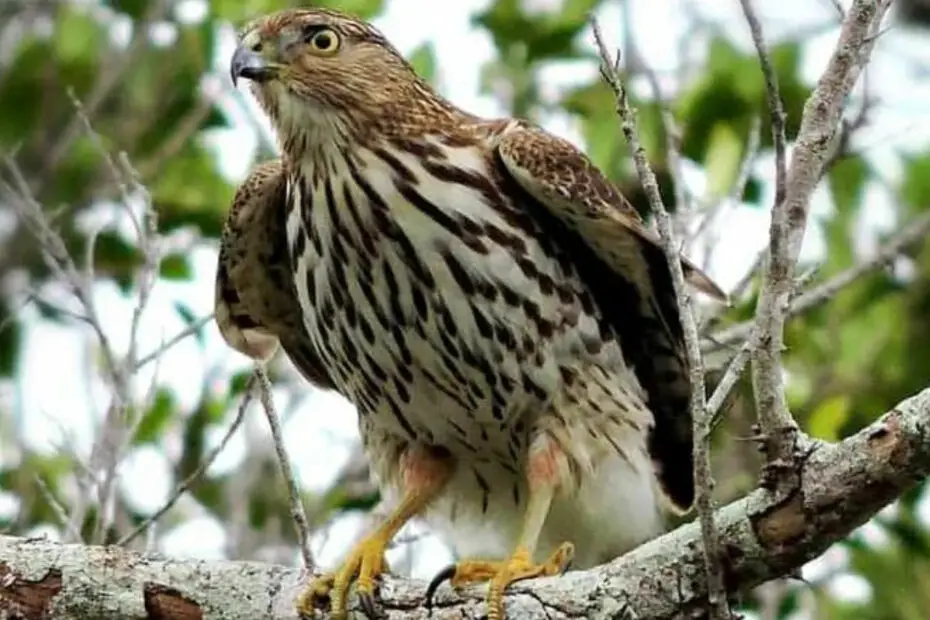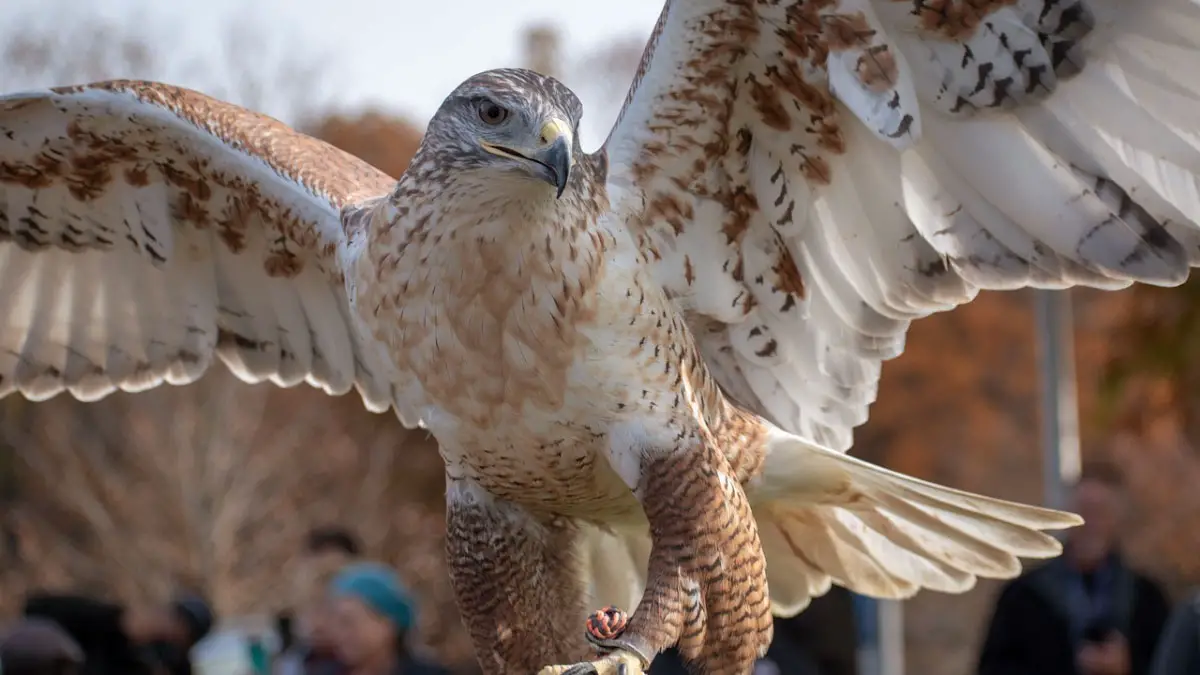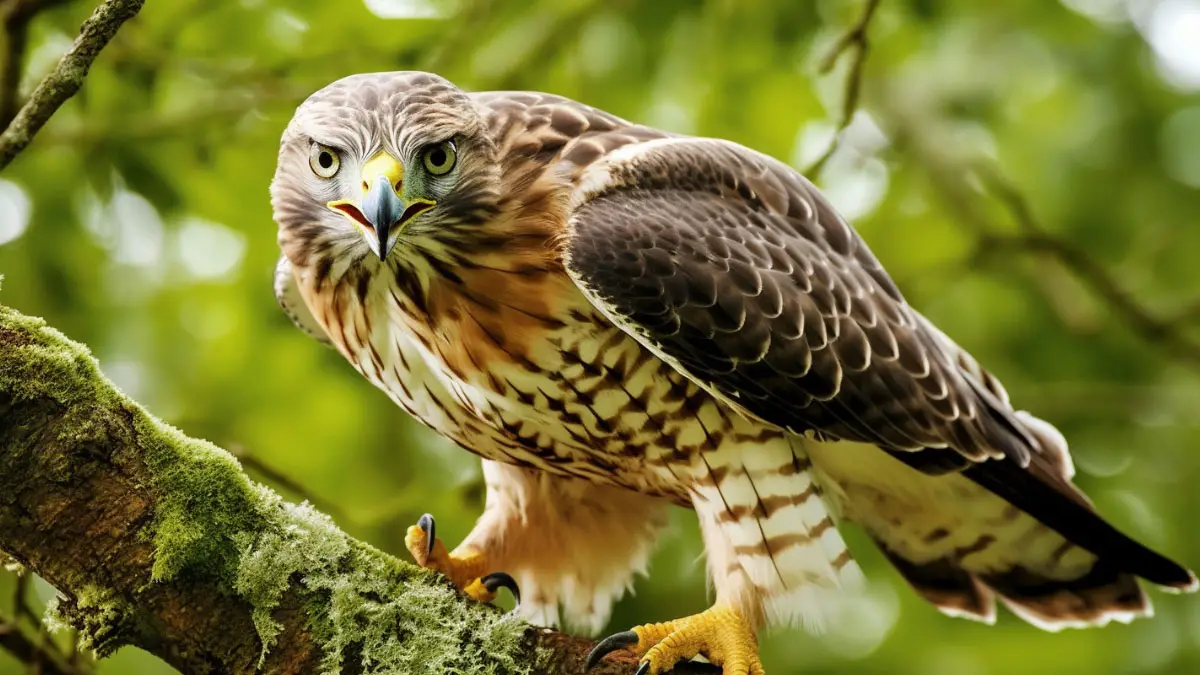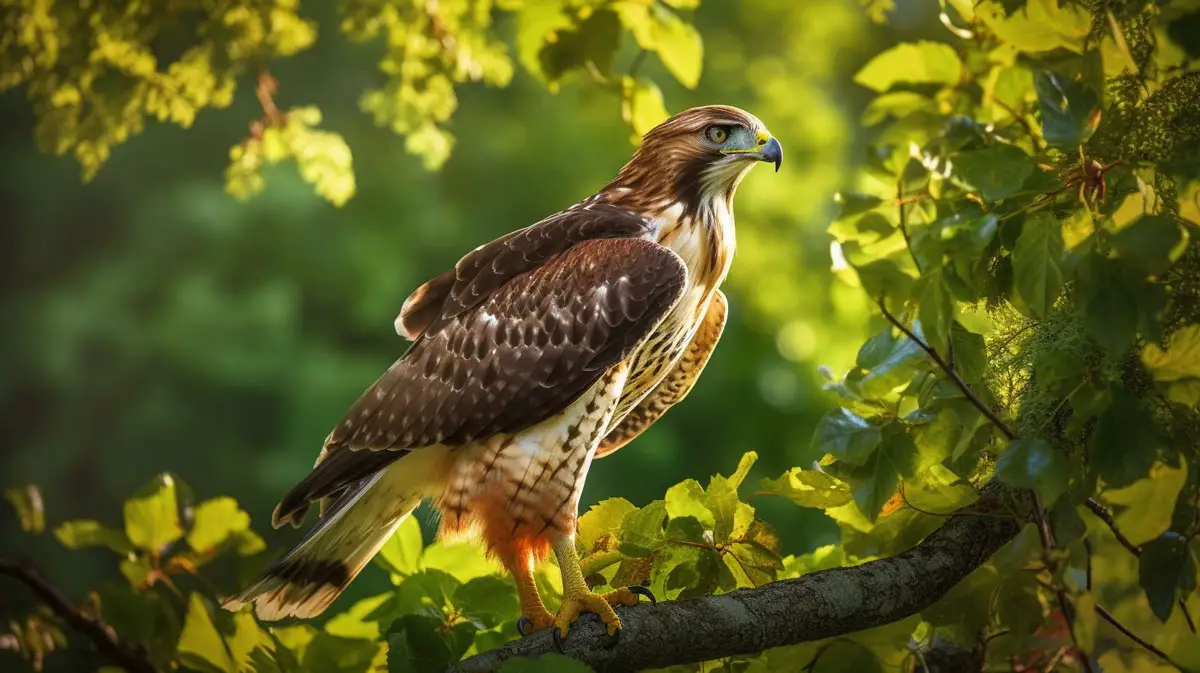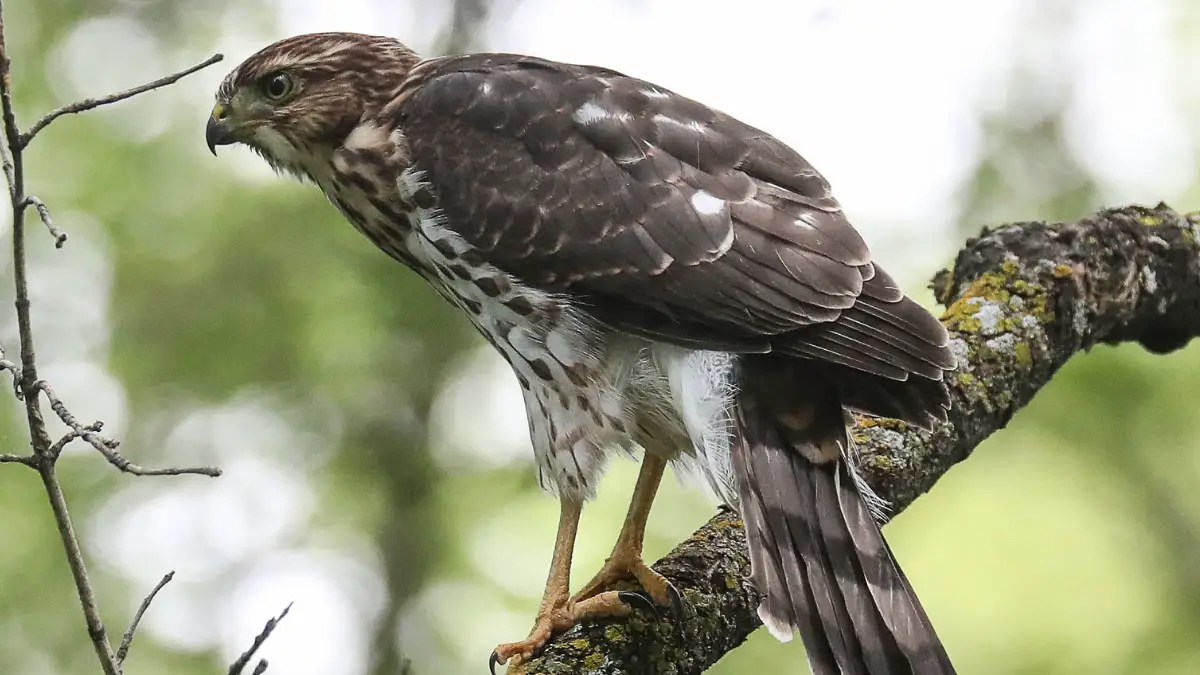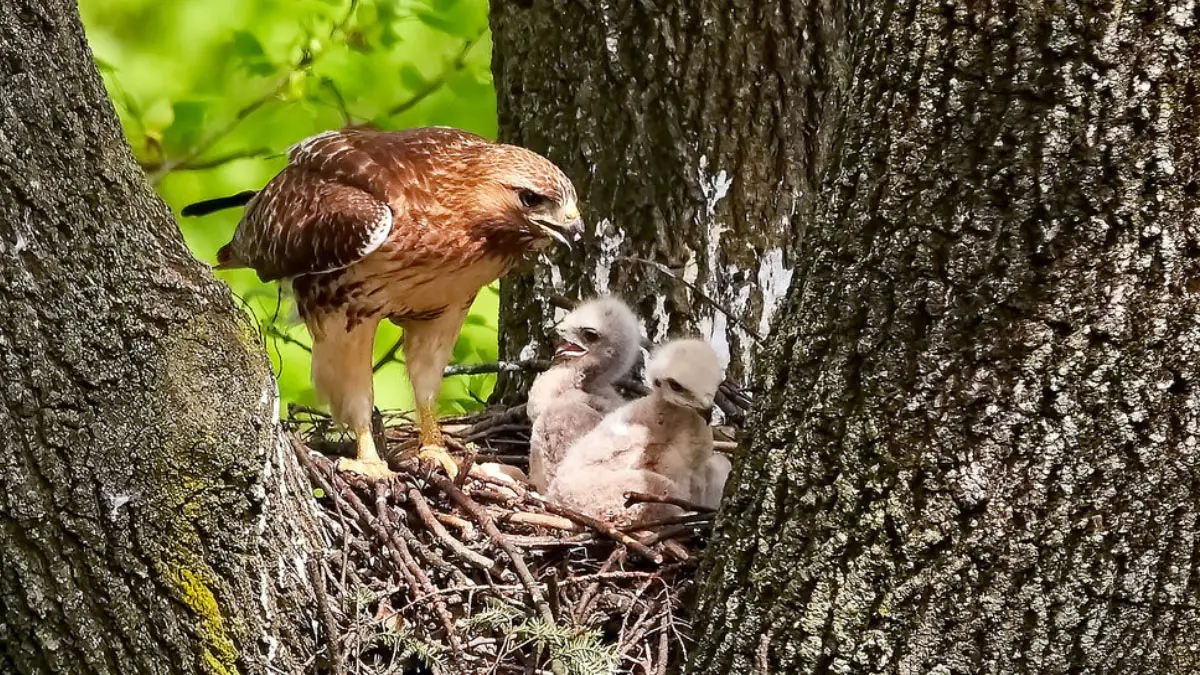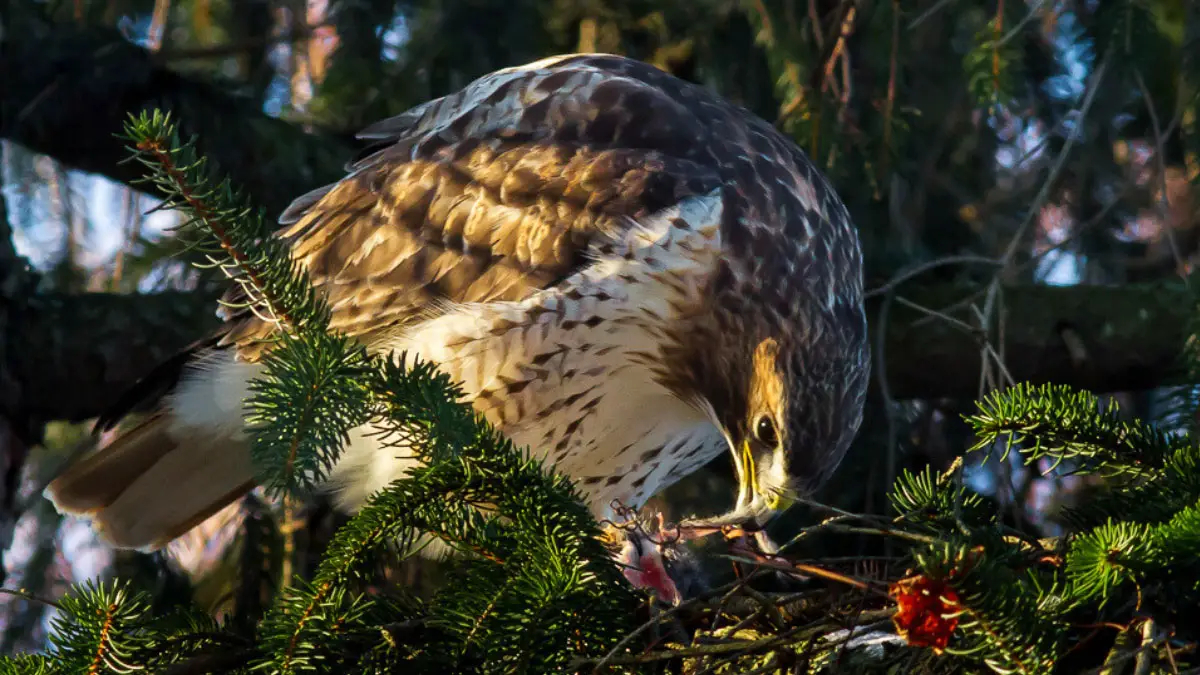Hawk identification can be challenging, as several species look similar at first glance. Hawk identification is critical for several reasons. For starters, it assists birders and ornithologists in understanding the distribution and behavior of various hawks, which can aid conservation efforts.
Researchers can identify potential threats to hawk populations and develop protection strategies by knowing where and when they are found.
Hawks are members of the Accipitridae family, including eagles. The most common hawk genera are Buteo, Accipiter, and Circus. Red-tailed Hawk, Cooper’s Hawk, Sharp-shinned Hawk, Northern Goshawk, and Ferruginous Hawk are the most common hawks.
Furthermore, identifying hawks can be a fun and rewarding experience for birdwatchers because it allows them to appreciate the diversity of these birds. Each hawk species has its unique characteristics and inhabit a wide range of habitats, including deserts, grasslands, forests, and urban areas.
This article is a comprehensive guide to identifying different types of hawks, their characteristics, and photos for easy identification.
Types Of Hawks
There are over 250 different hawks species, each with distinct characteristics and adaptations. These species can be divided into two main categories: accipiters and buteos.
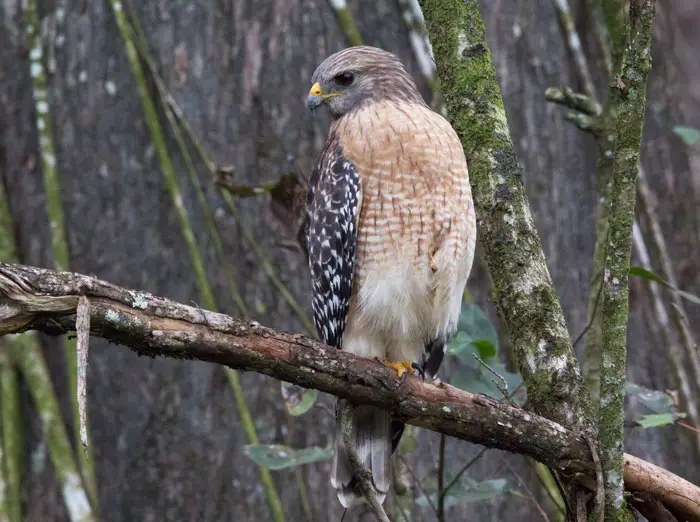
The Accipiter group consists of six genera that distinguish various raptors. These genera are Micronisus, Urotriorchis, Megatriorchis, Melierax, and Erythrotriorchis. Accipiters are smaller hawks with short, rounded wings and long tails. Examples of Accipiters include The Sharp-Shinned Hawk, Cooper’s Hawk, and Northern Goshawk.
The Buteo group comprises four genera: Buteo, Parabuteo, Geranoaetus, and Leucopternis. Buteos are larger hawks with broad, rounded wings and shorter tails, which allow them to soar over open areas while hunting. Buteos include the Red-tailed hawk, Hawaiian Hawk, Gray Hawk, and Ferruginous Hawk, among others.
Brief Description of Common Hawk Characteristics Of Each Species
1. Red-tailed hawk (Buteo jamaicensis)
This hawk is a large bird of prey, measuring about 18-26 inches long with a wingspan of 44-52 inches. They weigh approximately 2-4 pounds, with females slightly larger than males.
Their beak is large and hooked, with a pale yellow color, and their eyes are dark brown. They have a pale, cream-colored head with dark patches around the eyes. Their plumage is dark brown, and they have a distinct reddish-brown tail, giving them their name.
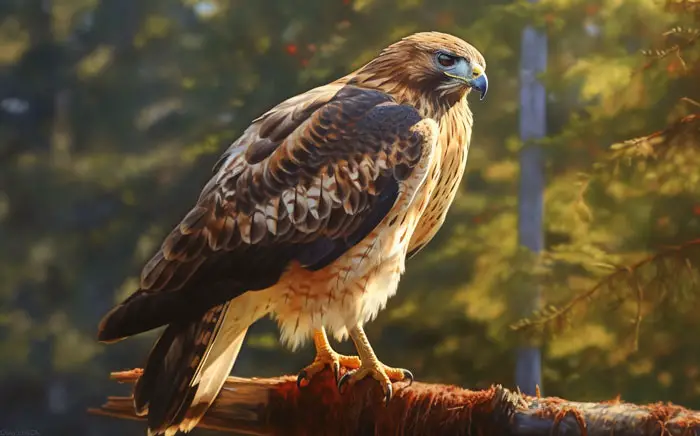
Their underparts are pale with a striped pattern, and they have a dark belly band. Their beak is hooked, sharp, and curved, adapted for tearing apart prey.
They have broad, rounded wings with finger-like extensions at the tips adapted for soaring and gliding. Their habitat ranges from forests to open fields and is also commonly found throughout North America, from Alaska and Canada to Mexico and Central America.
2. Cooper’s hawk (Accipiter cooperii)
Cooper’s hawks are medium-sized, measuring about 14-20 inches long, with a wingspan of 28-36 inches. They weigh approximately 12-24 ounces.
The adult Cooper’s hawk has a bluish-gray back, a black cap, a reddish-brown chest, and underparts. Juveniles have brown upper parts and streaked underparts.
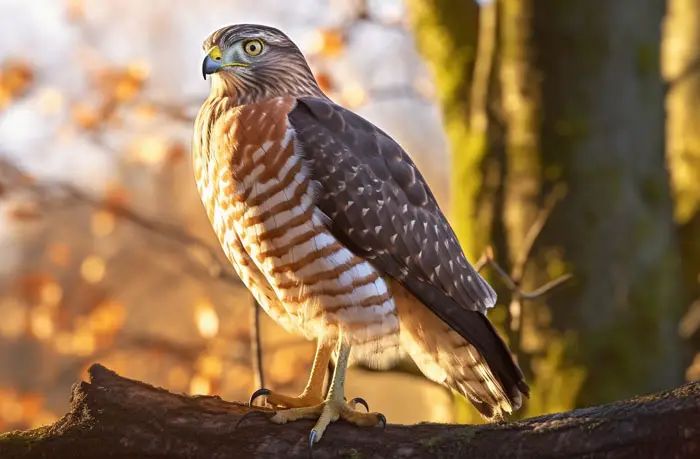
Their beak shape is sharp, hooked, and adapted for capturing and killing prey. They also have broad, rounded wings with a squared-off tip.
They are found throughout North America, from southern Canada to Central America. They mainly inhabit wooded habitats, including forests, woodlots, and suburban areas.
3. Sharp-shinned hawk (Accipiter striatus)
This hawk is a small bird, measuring around 9-14 inches long, with a wingspan of 1.5-2.5 feet. They weigh around 5 ounces.
The adult Sharp-shinned hawk has a bluish-gray back, a reddish-brown chest, and narrow, barred tail feathers.
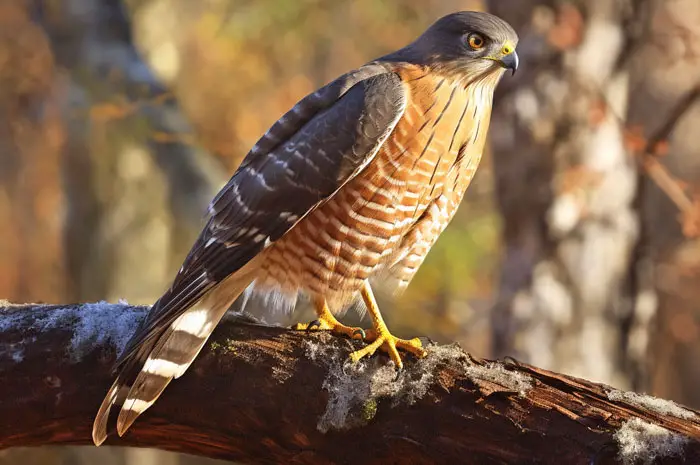
The beak is short and sharply curved, with a sharp, hooked tip. Its wing shape is narrow and pointed with a rounded tip. They are found throughout North America, from Alaska to Central America.
During breeding, they prefer to nest in dense, mature trees in forested areas such as coniferous, deciduous, and mixed forests. They can be found in various habitats during the winter, including woodlands, parks, and suburban areas, where they feed on small birds and mammals.
4. Harris’s hawk (Parabuteo unicinctus)
The Harris hawk has a wingspan of up to 3.5 feet and a body length of up to 24 inches. They weigh approximately 1.5 pounds. It has a distinctive, broad, rounded tail and a broader wingspan than many other hawks.
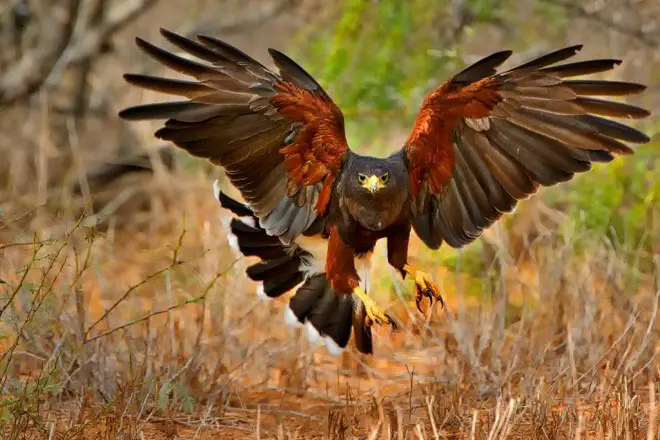
An adult Harris’s hawk has a dark brown back and wings, a reddish-brown plumage, and a white-tipped tail. The head is also lighter in color than the rest of the body, with a distinctive dark patch around the eyes.
The Harris’s Hawk has a large, powerful, hooked grayish-blue beak. It is used to tear apart prey and can also be used as a weapon to defend against predators.
Harris’s hawks are found in open country and desert habitats, from the southwestern United States to South America.
5. The Northern Goshawk (Accipiter gentilis)
This bird measures 20-27 inches long with a wingspan of 3-4 feet. They weigh approximately 2-4 pounds. Northern Goshawks are distinguished by their gray and white banded underbodies and a white stripe above their eyes.
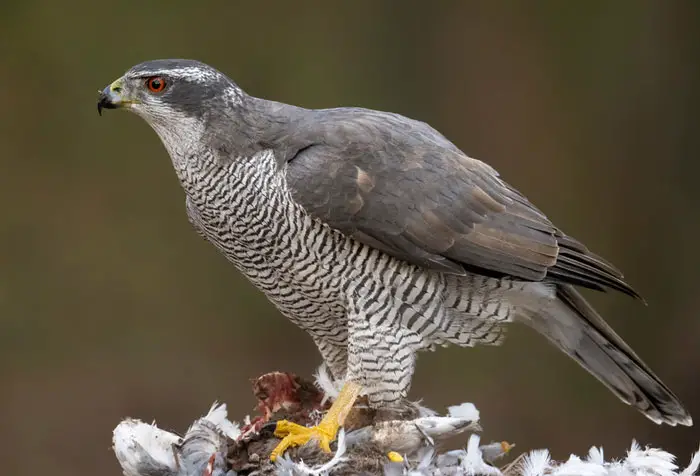
They are easily identified by their dark heads and bright red eyes. Their range includes most of the United States, Canada, and the Arctic tundra. Northern goshawks’ habitat includes coniferous forests and wooded areas.
6. Ferruginous Hawk (Buteo regalis)
This hawk boasts the impressive title of being the largest of its kind, with a wingspan that can stretch up to 60 inches (1.5 meters) and a weight that can reach up to 5 pounds.
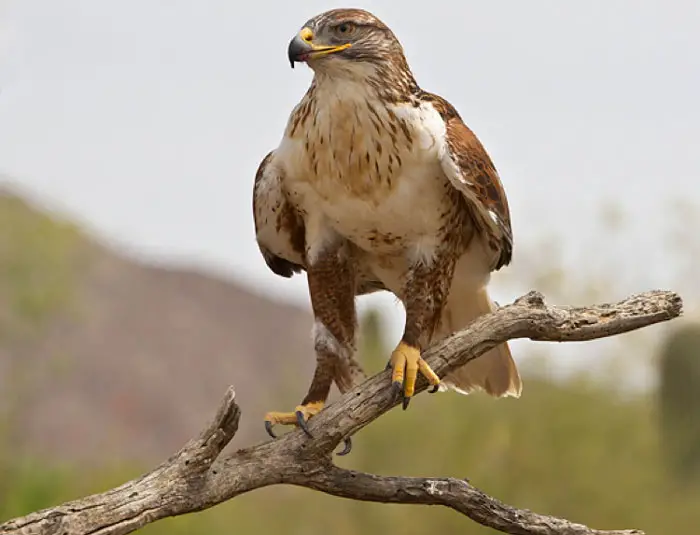
They have reddish-brown backs and wings, a pale chest, and a white or pale brown head. Ferruginous hawks are found in open habitats, including grasslands and deserts. Another distinguishable attribute about this hawk is they can nest anywhere, from high places to anywhere on the ground.
Here is a video to help you out more about other hawk species.
Hawk Identification Tips
Anyone who indulges in bird watching may find it quite challenging to identify different hawks. However, with some knowledge and practice, it is possible to become proficient in bird identification. There are several critical physical features that you should pay attention to. They include:
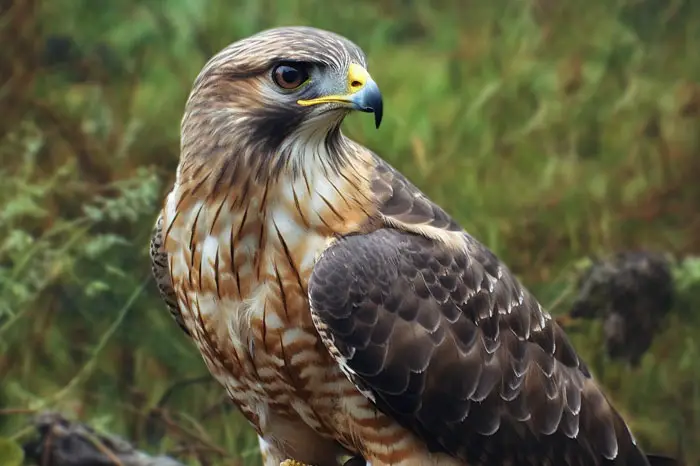
Wing Shape
Some hawks, such as the red-tailed hawk, are larger and have broad wings rounded at the tips. Other hawks, such as Cooper’s hawk, are smaller and have longer wings that are pointed at the tips.
Plumage
Different hawks have different patterns of coloration on their feathers, including bars, streaks, and spots. For example, the rough-legged hawk has dark feathers on its back and a white belly, while the sharp-shinned hawk has dark stripes on its breast.
Beak
The shape of the beak can also help you identify the species. Like Cooper’s hawk, some have a hooked beak sharply curved at the tip. Other hawks, such as the red-tailed hawk, have a hooked beak that is not as sharply curved.
Eyes
Hawks have large, round eyes positioned on the front of their heads. This gives them excellent depth perception and allows them to judge distances when hunting accurately.
The color of a hawk’s eyes can also help identify the species. For example, the eyes of a red-tailed hawk are dark brown, while the eyes of Cooper’s hawk are yellow.
Common Mistakes In Identifying Hawks
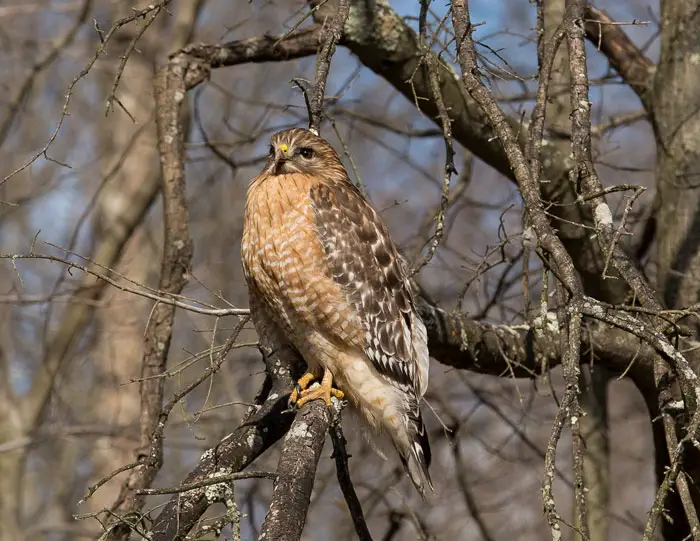
Here are some common mistakes people make when identifying hawks. So please, keep these facts in mind, and be precise by avoiding such mistakes.
- Misjudging size and distance: Hawks can appear larger or smaller depending on their position and length from the observer.
- Misidentifying juvenile hawks: Juvenile hawks can be challenging to identify since they often have different plumage and markings than adult hawks.
- Confusing similar species: Cooper’s and sharp-shinned hawks have similar plumage patterns and can be difficult to distinguish. Paying attention to key features such as size, shape, and markings can help differentiate between these species.
- Relying too much on birding field guides: While helpful, they may not accurately represent a hawk’s appearance. Observing the hawk and depending on your observations is essential, rather than solely relying on a guide.
Tips For Identifying Hawks In Flight
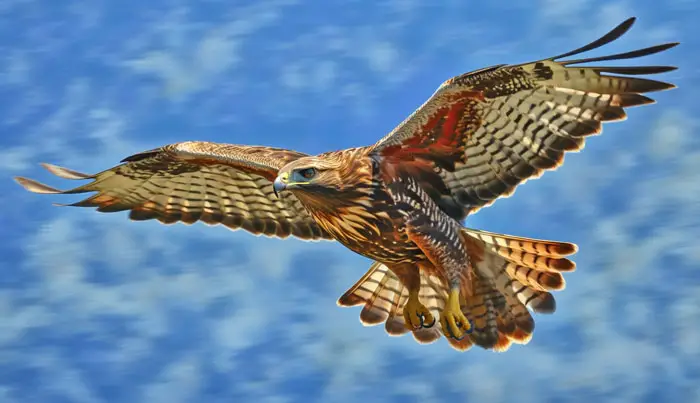
Here are some tips on how to identify different types of hawks in flight:
- Look at the shape of the wings: For example, the broad wings of the red-tailed hawk form a shallow “V” shape, while the pointed wings of Cooper’s hawk are more narrow and angular. Also, pay attention to the tail shape. Some hawks have broad, rounded tails, while others have long, squared-off tails with dark bands.
- Observe the flight pattern: Hawks typically fly in a steady, flapping way interspersed with periods of soaring. They often circle or glide in thermal currents to conserve energy. For example, the red-tailed hawk tends to soar in wide circles, while Cooper’s hawk flies in a more direct, powerful manner.
- Look for distinctive markings: Look for bars, streaks, or spots on the hawk’s breast or wings. For example, the Red-tailed Hawk has a red tail visible in flight, and the Broad-winged Hawk has a bold white and black band across its tail.
- Take note of behavior: For example, the sharp-shinned hawk is known for its agile, acrobatic flight patterns, while the northern harrier flies low over fields in search of prey.
- Take note of the bird’s size: While it can be challenging to judge a bird’s size in flight, paying attention to relative size can help with identification. For example, the Cooper’s Hawk is roughly the size of a crow, while the Red-tailed Hawk is much larger, approximately the size of a goose.
Resources For Learning More About Hawk Identification
Here are some of the best resources for learning about bird identification:
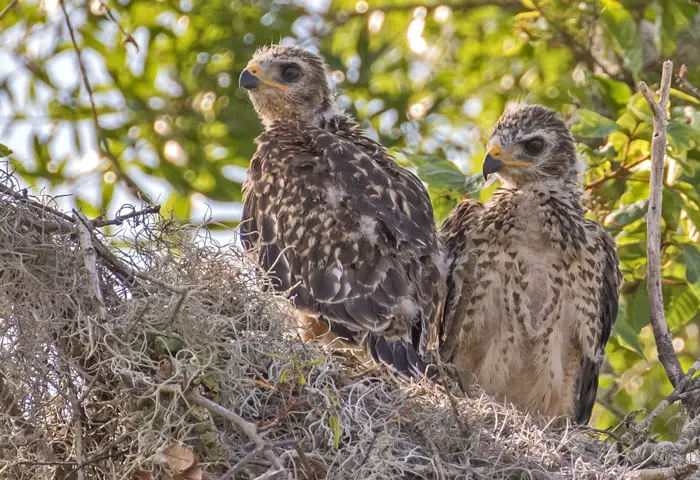
- Field guides: Look for guides specific to your region, as different species of hawks are found in other parts of the world.
- Online resources: Websites like the Cornell Lab of Ornithology and the Audubon Society provide detailed information on different hawk species, including photos and audio recordings of their calls.
- Bird-watching organizations: You’ll have the opportunity to learn from experienced bird watchers, who can help you identify different hawks in the field.
- Workshops and classes: These classes may be available at local nature centers, birding festivals, or online.
- Apps: These apps often include hawk photos, sounds, and other information to help with identification.
- Online communities: Joining online communities of bird watchers and hawk enthusiasts can be a great way to learn more about hawk identification. These communities often provide a forum for discussion and sharing of information, and you can learn a lot from the experiences of other bird watchers.
Best Photos for Hawk Identification
Having high-quality photos of hawks can be extremely helpful in identifying the species of a hawk. It is beneficial when trying to distinguish between similar species or subspecies of hawks.
Bird photography can also aid in recording the presence of a specific hawk species in a particular area, which can be important for scientific research and conservation efforts.
Examples Of High-Quality Hawk Photos For Identification
Here are some examples of the best hawk photos for identification.
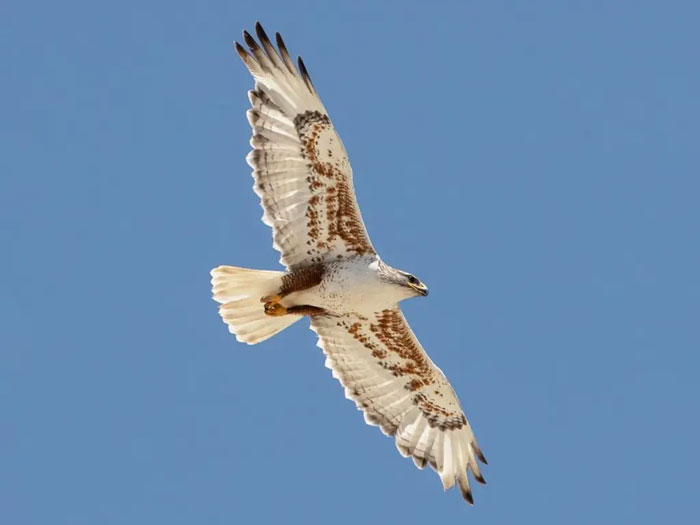
The above photo shows a Ferruginous hawk. Their pale chests and tail wings mainly distinguish them. Their flight wings have reddish-brown streaks, which is mostly what you will see when the hawk is in flight.
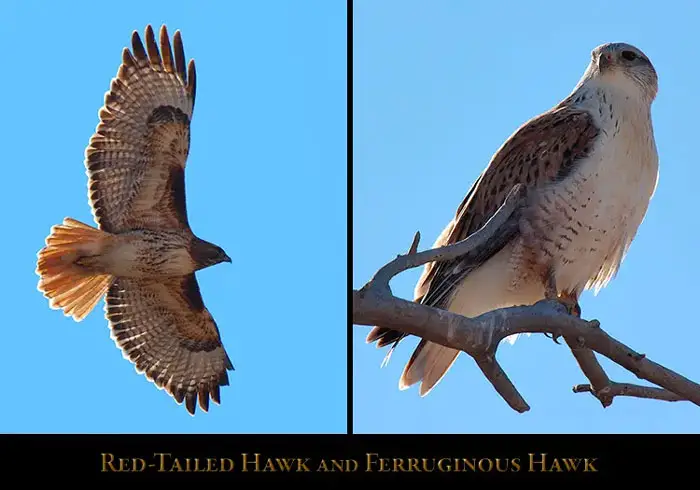
This is a red-tailed hawk. As you can see, the hawk has dark brown feathers on its wings and lighter brown feathers on its chest and belly. The tail feathers are a distinctive reddish-brown color.
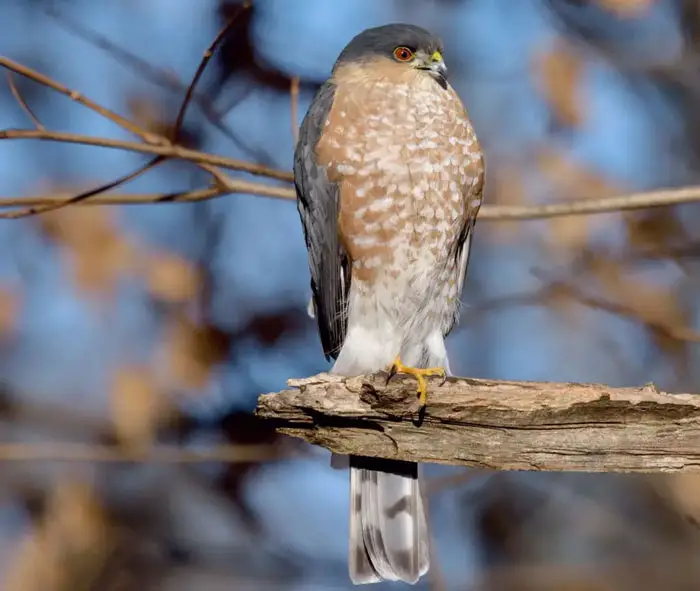
This is a sharp-shinned hawk. It has dark blue-gray feathers on its back and wings and lighter gray feathers on its chest and belly. It is among one of the smaller hawk species.
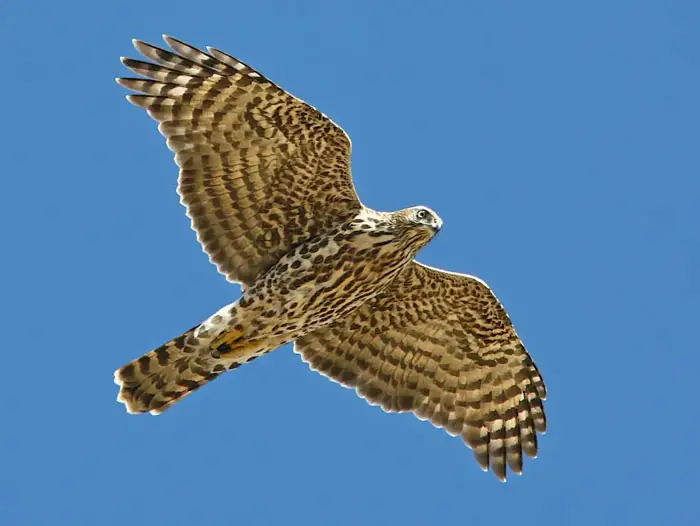
This is a Northern goshawk. It is among the most easily identifiable hawks due to their gray and white banded underbodies.
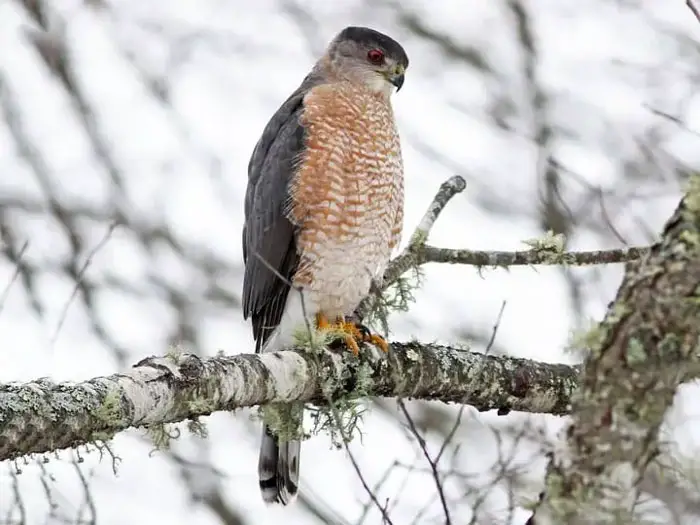
This is the Cooper’s hawk. Cooper’s Hawks and Sharp-shinned Hawks are two species of birds of prey that can be easily confused due to their similar appearance.
However, the Cooper’s Hawks are larger than Sharp-shinned Hawks and have a distinctive black cap on their heads.
Tips For Taking Good Photos Of Hawks
- Use a high-quality camera: Invest in a good camera that can capture clear, detailed images. A camera with a fast shutter speed is essential for capturing hawks in flight.
- Use a long lens: Hawks are often seen from a distance, so it is essential to capture them in detail. A lens with a focal length of at least 300mm is recommended.
- Get close to the action: Get as close as possible to the hawk you photograph. This will ensure that you capture the details you need for identification.
- Consider lighting: Lighting can make or break a photo. Avoid taking photos of hawks in direct sunlight or harsh shadows, as this can create unflattering contrast and make it difficult to see important details.
- Be patient: Hawks are fast and unpredictable, so getting the perfect shot may take some time. Be prepared to wait and keep your camera ready for the perfect moment.
- Practice ethical photography: Avoid disturbing or harassing the birds, and never put their welfare at risk to get a good shot.
- Use burst mode: If your camera has a burst mode, rapidly capture multiple shots. This can help you capture the perfect moment when the hawk is in the ideal position.
Hawk Migration
Some species, such as the Broad-winged Hawk and the Swainson’s Hawk, migrate in large flocks known as kettles.
At the same time, others, like the Red-tailed Hawk and the Cooper’s Hawk, migrate alone or in small groups. Hawks use thermals, rising columns of warm air, to gain altitude and conserve energy during migration.
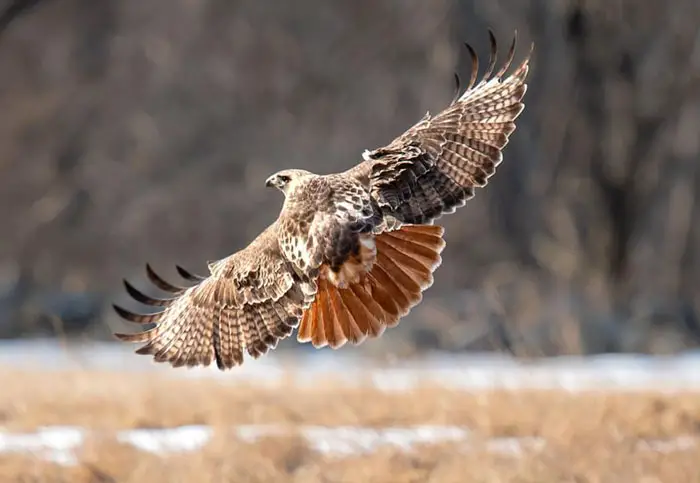
Timing Of Hawk Migration
The timing of hawk migration varies depending on the species and the location. In North America, the peak of hawk migration generally occurs in late September to early November for fall migration and in mid-March to mid-May for spring migration. The exact timing may vary yearly, depending on weather patterns and other factors.
Hawks are known for their impressive long-distance migrations. Some species, such as the Broad-winged Hawk, travel up to 4,000 miles from their breeding grounds in North America to their wintering grounds in South America.
Other species, such as the Red-tailed Hawk, may migrate shorter distances or not at all, depending on their location and food availability.
How To Identify Migrating Hawks
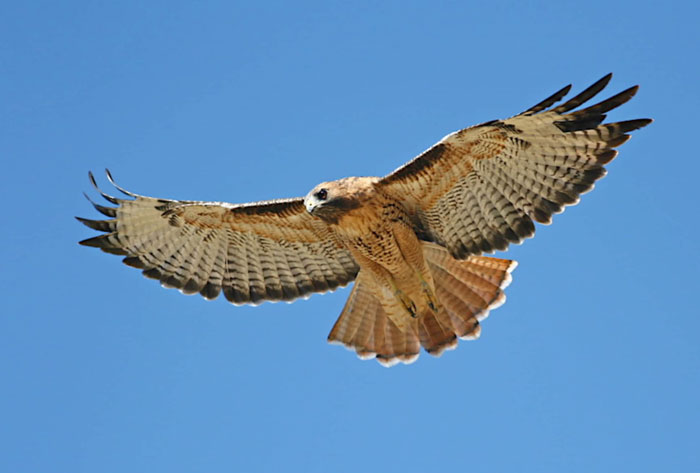
Here are some tips to help you identify migrating hawks.
- Know the time and location of migration: Migrating hawks are usually seen in large numbers between September and November during fall. They can be found in various areas, such as coastal headlands, mountain ridges, and inland hills.
- Look for soaring hawks: Migrating hawks often soar in thermals, which are columns of rising warm air, to gain altitude without flapping their wings. Look for hawks soaring in a circular motion or a straight line.
- Observe their shape and size: Hawks have broad wings and a long tail that helps them maneuver in the air. They are typically smaller than eagles but larger than falcons. Look for their distinctive shape, and note their size and proportion.
- Watch for their behavior: Hawks have unique behaviors, such as kettling, where they circle in a tight group, and stooping, where they dive down to catch prey.
- Use a guide: Hawk identification guides provide detailed information on the different species of hawks and their characteristics.
- Take photographs: This can help you compare with images in a field guide or online.
FAQs
Here are some other related questions about hawk identification.
Falcons have a more pointed wing shape, while hawks have a broader, rounded shape. Falcons also have a more distinct notch in their beak, while hawks have a more uniform shape. Additionally, falcons are typically smaller in size than hawks.
Eagles are larger than hawks, with longer, more prominent beaks and longer wingspans. Eagles also have a more distinct “V” shape when soaring, while hawks have a more rounded shape. Eagles also tend to prefer living near bodies of water, while hawks can be found in various habitats.
Hawks typically build their nests in high places like tall trees, cliffs, or artificial structures such as power poles or buildings. Once you’ve determined the general area, you can look for the nest.
A hawk’s nest is typically made of sticks lined with softer materials such as leaves or grass. It is often large and bulky, measuring 3-4 feet across.
Attracting hawks to your backyard can be tricky, as they require large open spaces to hunt. They typically only visit urban areas if a good food source is available. However, providing bird feeders and baths can attract smaller birds which hawks may prey upon.
It’s important to note that attempting to attract hawks to your backyard should be done with caution, as they are wild animals and should be respected as such.
Several ways to contribute to hawk conservation efforts include supporting birding organizations that focus on raptor conservation, reporting sightings of injured or sick hawks to wildlife rehabilitation centers, and advocating for conservation policies that protect hawk habitats.
Additionally, avoiding harmful pesticides and other chemicals can help protect the food sources that hawks rely on.
Conclusion
Identifying different species of hawks and their behavior patterns is essential, as this knowledge can help conserve these birds and their habitats. With the right resources and techniques, identifying hawks becomes easier and more rewarding, allowing us to appreciate their unique features and understand their ecological roles.
Wildlife conservation is crucial for the survival of hawk populations and other species that share their habitats. It is because they play crucial roles in their local ecosystem and its food chain.
We can contribute to hawk conservation efforts by supporting conservation organizations, reporting sightings of injured or threatened birds, and advocating for the protection of natural habitats. Furthermore, we can encourage more people to appreciate hawks and other wildlife by sharing our knowledge and experiences.
If you want to learn more about hawks, many resources are available, including field guides, online identification tools, and bird-watching communities. Learning about these magnificent birds can deepen our appreciation for the natural world and contribute to its conservation for future generations.
